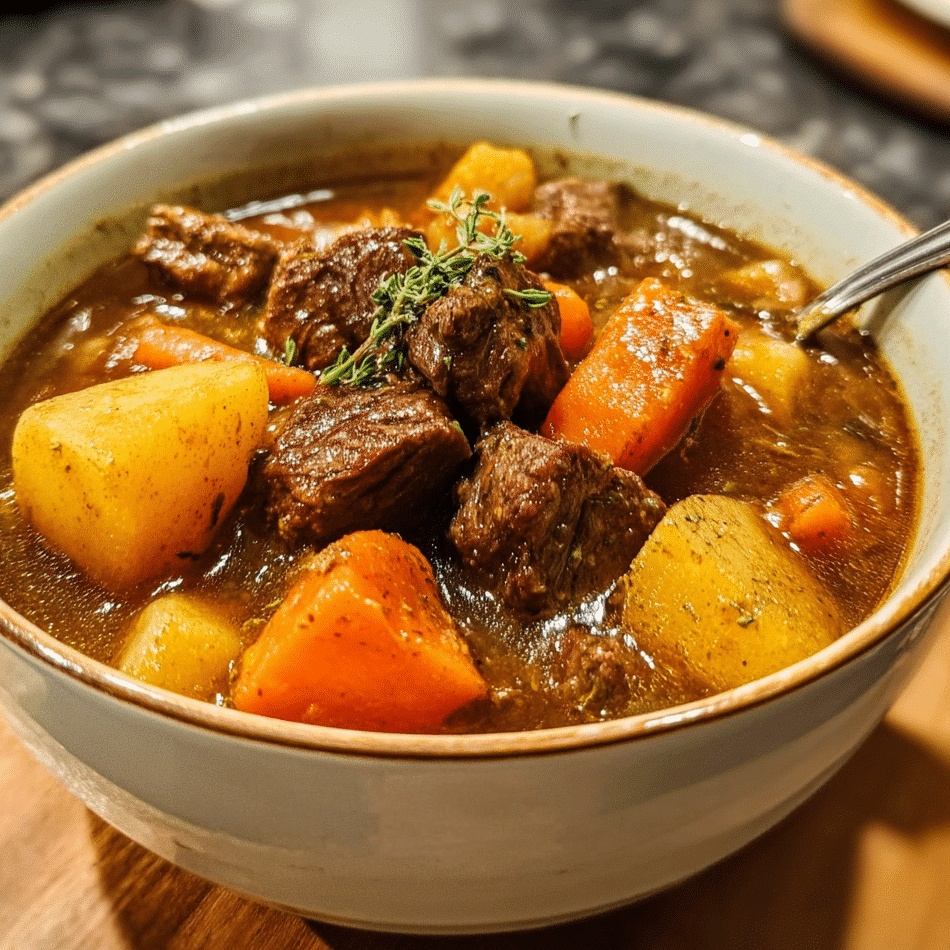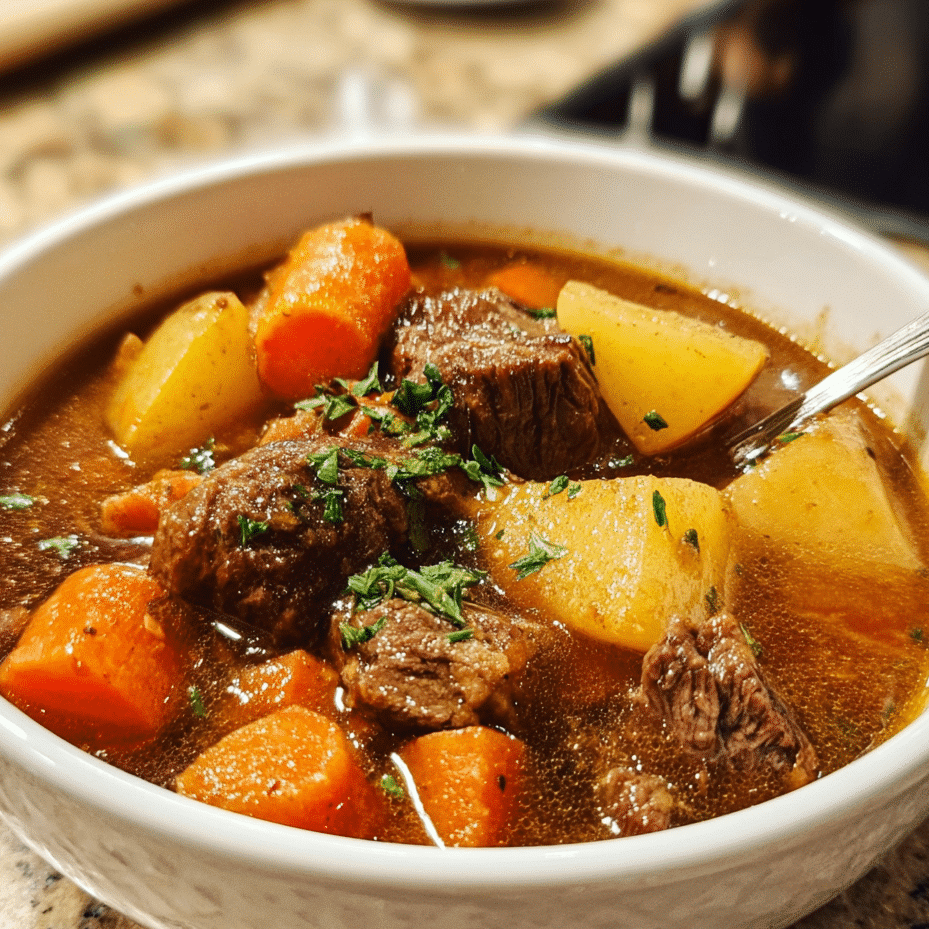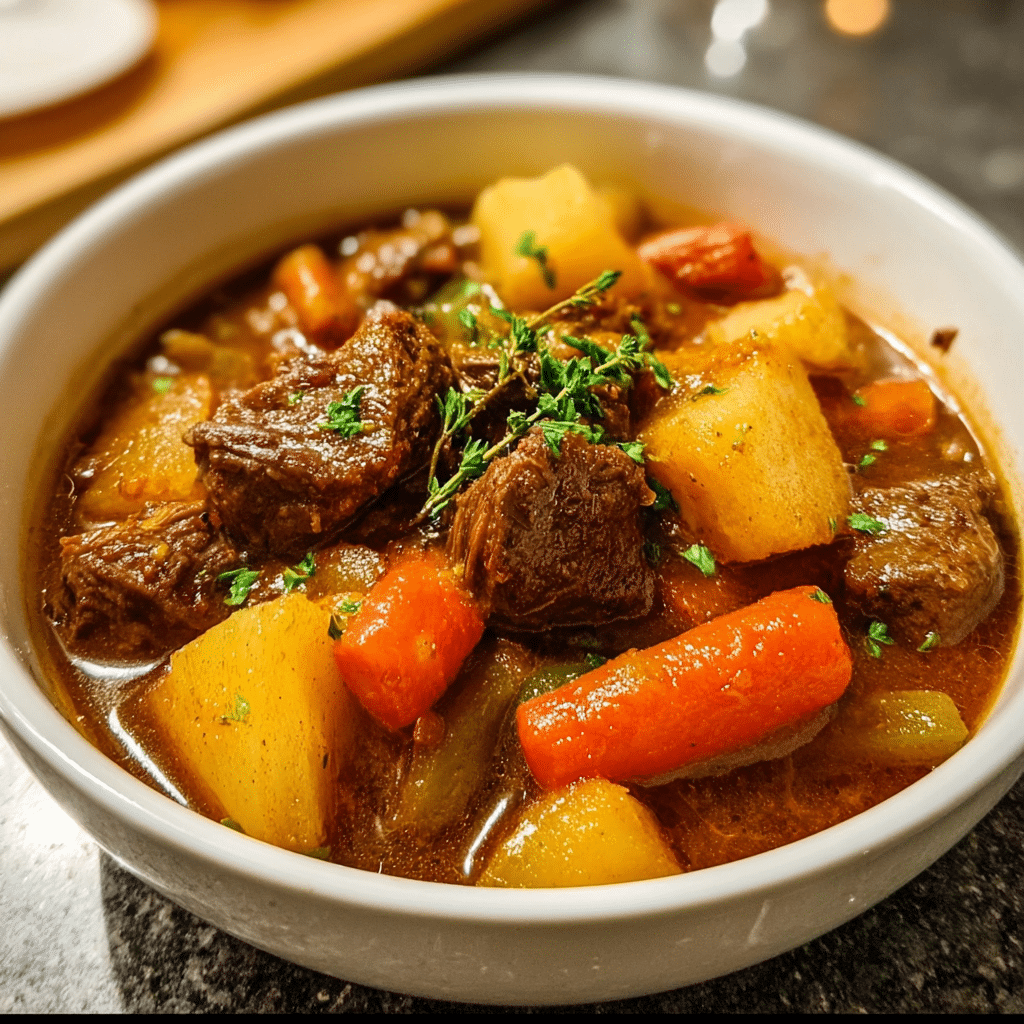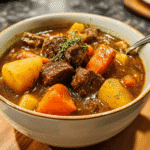Apple Cider Beef Stew is the ultimate comfort food that transforms tough cuts of meat into tender, flavorful perfection. Are you tired of bland, watery stews that leave you disappointed? This recipe promises a rich, aromatic stew that fills your home with the warm scents of fall and delivers melt-in-your-mouth beef in every spoonful.
Hi there! I’m Lisa from Recipesrealm, and after years of perfecting comfort food recipes, I’ve discovered the secret to creating the most incredible Apple Cider Beef Stew. The magic happens when apple cider’s natural sweetness and acidity work together to break down tough fibers while infusing the meat with incredible depth of flavor. This isn’t just another stew recipe—it’s a game-changer that will become your family’s new fall tradition.
In this comprehensive guide, you’ll discover professional meat selection techniques, foolproof cooking methods, and insider tips that guarantee restaurant-quality results every time. We’ll cover everything from choosing the perfect cut of beef to serving suggestions that will impress your guests.
Why This Apple Cider Beef Stew Recipe Works
This Apple Cider Beef Stew delivers on three crucial fronts: exceptional flavor, incredible convenience, and remarkable versatility that makes it perfect for any occasion.
• Uses affordable, easy-to-find cuts of meat – Chuck roast and other tough cuts become incredibly tender through slow cooking • Develops complex flavors in just 15 minutes of prep – The apple cider marinade penetrates deep into the meat • Perfect for busy weeknights or special weekend gatherings – Set it and forget it cooking method • Creates rich, restaurant-quality results at home – Professional techniques simplified for home cooks • Naturally gluten-free and dairy-free options available – Accommodates various dietary needs • Scales easily for meal prep or large families – Double or triple the recipe with consistent results
The apple cider serves as both a tenderizing agent and flavor enhancer, breaking down tough muscle fibers while adding natural sweetness that balances the savory herbs and spices. This scientific approach to cooking ensures every bite is tender and flavorful.
Choosing the Right Meat for Apple Cider Beef Stew
Selecting the proper cut of beef is absolutely critical for achieving the perfect Apple Cider Beef Stew. The wrong choice can result in tough, chewy meat that no amount of cooking can save.
Best Cuts for This Apple Cider Beef Stew Recipe
Chuck roast reigns supreme for this Apple Cider Beef Stew because of its ideal fat-to-muscle ratio and abundant connective tissue. When slow-cooked, the collagen breaks down into gelatin, creating that luxurious, silky texture that coats your spoon. The marbling throughout chuck roast ensures each bite remains juicy and flavorful.
Beef short ribs offer another excellent option, providing even richer flavor due to their higher fat content. The bones add extra depth to the broth, creating a more complex Apple Cider Beef Stew. Bottom round roast works well for those preferring leaner cuts, though it requires careful monitoring to prevent overcooking.
Avoid lean cuts like sirloin or tenderloin, as they lack the necessary fat and connective tissue to withstand long cooking times. These premium cuts are better reserved for quick-cooking methods.
Buying Tips for Apple Cider Beef Stew Success
Look for beef with bright red color and minimal gray or brown spots, indicating freshness. The meat should feel firm to the touch, not mushy or slimy. Good marbling—white fat streaks throughout the muscle—signals superior flavor and tenderness in your finished Apple Cider Beef Stew.
Ask your butcher to cut chuck roast into 2-inch cubes, saving you prep time while ensuring uniform cooking. Request they trim excess external fat but leave some for flavor. Many butchers will do this at no extra charge when purchasing larger roasts.
Check the packaging date and choose the freshest available. Properly stored beef should have no off-odors when you open the package.
Substitutions for Apple Cider Beef Stew
Lamb shoulder makes an excellent substitute, creating a more robust, gamey Apple Cider Beef Stew that pairs beautifully with fall spices. Venison works similarly for those with access to game meat.
For poultry lovers, bone-in chicken thighs provide the necessary fat content for slow cooking, though cooking time reduces to 2-3 hours. Turkey thighs offer another alternative with similar cooking requirements.
Vegetarians can substitute hearty mushrooms like portobello or shiitake, using vegetable stock instead of beef broth while maintaining the apple cider base for that signature flavor.

Ingredients & Prep for Apple Cider Beef Stew
Proper preparation sets the foundation for exceptional Apple Cider Beef Stew. Quality ingredients and careful prep work make the difference between good and extraordinary results.
Meat Prep Essentials for Apple Cider Beef Stew
Pat the beef completely dry with paper towels before seasoning—this crucial step ensures proper browning and prevents steaming. Moisture on the meat’s surface creates steam, preventing the Maillard reaction that develops complex flavors essential to great Apple Cider Beef Stew.
Cut meat into uniform 2-inch pieces to ensure even cooking. Smaller pieces cook too quickly and may fall apart, while larger chunks take too long to become tender. Trim excess fat but leave some for flavor and moisture.
Season generously with salt and pepper 30 minutes before cooking, allowing the seasoning to penetrate the meat. This dry-brining technique enhances flavor throughout your Apple Cider Beef Stew.
Essential Ingredients for Apple Cider Beef Stew
For the Base:
- 3 pounds chuck roast, cut into 2-inch cubes
- 2 cups fresh apple cider (not apple juice)
- 2 cups beef broth, low sodium
- 2 large onions, diced
- 4 carrots, cut into 1-inch pieces
- 4 celery stalks, chopped
- 1 pound baby potatoes, halved
- 8 ounces mushrooms, quartered
For the Flavor Profile:
- 3 tablespoons tomato paste
- 4 garlic cloves, minced
- 2 bay leaves
- 2 sprigs fresh thyme
- 1 sprig fresh rosemary
- 2 tablespoons olive oil
- 2 tablespoons all-purpose flour
- Salt and black pepper to taste
For Enhanced Depth:
- 1 tablespoon Dijon mustard
- 2 tablespoons apple cider vinegar
- 1 tablespoon brown sugar
- 1 teaspoon smoked paprika
Pantry Staples for Perfect Apple Cider Beef Stew
Stock your pantry with these essentials that elevate any Apple Cider Beef Stew. High-quality olive oil provides the best flavor for browning meat. Choose extra virgin for its robust taste and high smoke point.
Apple cider vinegar serves multiple purposes—it tenderizes meat, brightens flavors, and balances the sweetness from the cider. Always use unfiltered, raw apple cider vinegar for maximum benefit.
Tomato paste adds umami depth and rich color to your Apple Cider Beef Stew. Look for double-concentrated paste in tubes for convenience and better flavor control.
Step-by-Step Cooking Instructions for Apple Cider Beef Stew
Follow these detailed steps to create the most incredible Apple Cider Beef Stew that will have your family asking for seconds and thirds.
Pre-Cooking Prep for Apple Cider Beef Stew
Remove the beef from refrigeration 30 minutes before cooking to bring it to room temperature. This ensures even cooking throughout your Apple Cider Beef Stew. Cold meat tends to cook unevenly, with the exterior overcooking before the center reaches proper temperature.
Pat each piece completely dry and season generously with salt and pepper. Toss the seasoned meat with 2 tablespoons of flour, coating each piece evenly. This flour coating helps thicken the stew naturally while creating a beautiful crust when browned.
Prepare all vegetables by washing, peeling, and cutting them into uniform sizes. Having everything ready before you start cooking prevents overcooking and ensures smooth preparation of your Apple Cider Beef Stew.
Cooking Method for Apple Cider Beef Stew
Heat olive oil in a large, heavy-bottomed Dutch oven over medium-high heat until shimmering. The oil should be hot enough that a small piece of meat sizzles immediately upon contact but doesn’t smoke.
Brown the beef in batches, avoiding overcrowding which would cause steaming instead of browning. Each piece should develop a rich, golden-brown crust that adds incredible depth to your Apple Cider Beef Stew. This process takes about 3-4 minutes per side and is absolutely crucial for developing complex flavors.
Remove browned meat and set aside. In the same pot, add onions and cook until softened and lightly caramelized, about 5 minutes. The fond (browned bits) left from the meat will dissolve into the onions, adding incredible richness to your Apple Cider Beef Stew.
Add garlic, tomato paste, and smoked paprika, cooking for another minute until fragrant. Pour in apple cider and beef broth, scraping up any remaining fond from the bottom of the pot. This deglazing step captures every bit of flavor for your stew.
Return the browned beef to the pot along with bay leaves, thyme, and rosemary. Bring to a gentle simmer, then reduce heat to low. Cover and cook for 1.5 hours before adding vegetables.
Doneness Check for Apple Cider Beef Stew
Test meat tenderness by piercing with a fork—properly cooked beef should offer no resistance and easily shred. The internal temperature should reach 190°F for optimal tenderness in your Apple Cider Beef Stew.
Vegetables should be fork-tender but not mushy. Potatoes should hold their shape while yielding easily to gentle pressure. Carrots should maintain slight firmness for the best texture contrast in your finished Apple Cider Beef Stew.
Taste and adjust seasoning, adding salt, pepper, or apple cider vinegar as needed. The flavor should be rich and balanced, with the apple cider providing subtle sweetness that complements the savory elements.
Final Resting for Apple Cider Beef Stew
Allow the completed Apple Cider Beef Stew to rest for 10 minutes before serving. This resting period allows the flavors to meld completely while the stew thickens to the perfect consistency.
Remove bay leaves and herb sprigs before serving. Stir in fresh herbs like parsley or chives for a bright finish that enhances both flavor and visual appeal of your Apple Cider Beef Stew.

Pro Tips for Perfect Apple Cider Beef Stew
These professional techniques ensure your Apple Cider Beef Stew achieves restaurant-quality results every single time you make it.
Avoiding Tough, Dry Meat in Apple Cider Beef Stew
Never rush the browning process—proper caramelization takes time but creates the foundation for exceptional Apple Cider Beef Stew flavor. Brown meat in small batches to maintain high heat and achieve proper searing.
Keep the cooking temperature low and steady. High heat causes proteins to contract rapidly, squeezing out moisture and creating tough, dry meat. Your Apple Cider Beef Stew should barely simmer, with just occasional bubbles breaking the surface.
Don’t overcook vegetables by adding them too early. Root vegetables need about 45 minutes to become tender, while more delicate vegetables like mushrooms only need 20-30 minutes in your Apple Cider Beef Stew.
Essential Tool Recommendations for Apple Cider Beef Stew
Invest in a heavy-bottomed Dutch oven for even heat distribution and superior browning capabilities. Cast iron or enameled cast iron works best for developing the deep, complex flavors essential to great Apple Cider Stew.
Use an instant-read thermometer to monitor both meat doneness and cooking temperature. This precision tool eliminates guesswork and ensures perfect results every time you make Apple Cider Stew.
A wooden spoon prevents scratching your cookware while effectively scraping up fond during the deglazing process. This technique is crucial for incorporating maximum flavor into your stew.
Storage & Reheating Apple Cider Beef Stew
Cool completely before refrigerating to prevent bacterial growth. Properly stored Apple Cider Stew keeps for up to 4 days in the refrigerator and maintains excellent quality.
Freeze portions in airtight containers for up to 3 months. Leave space at the top of containers to accommodate expansion during freezing. Label with dates to track freshness of your Apple Cider Beef portions.
Reheat gently over low heat, stirring occasionally to prevent sticking. Add a splash of beef broth or apple cider if the stew becomes too thick during reheating. Avoid microwaving if possible, as it can create uneven heating and tough meat.
Flavor Variations for Apple Cider Beef Stew
Transform your basic Apple Cider Stew recipe into exciting new variations that keep this comfort food fresh and interesting throughout the fall season.
Spicy Twist on Apple Beef Stew
Add 2-3 chipotle peppers in adobo sauce for smoky heat that complements the apple cider’s sweetness perfectly. The peppers’ smokiness enhances the overall complexity of your Apple Beef Stew.
Incorporate 1 teaspoon of cayenne pepper for those who prefer straightforward heat without additional flavors. Start with less and adjust to taste, as the heat intensifies during the long cooking process.
Fresh jalapeños, seeded and diced, provide bright heat that doesn’t overpower the delicate apple notes in your Apple Cider Stew. Add them during the last 30 minutes of cooking to maintain their fresh flavor.
Keto/Paleo Version of Apple Cider Beef Stew
Replace potatoes with turnips or radishes, which become surprisingly mild and creamy when slow-cooked. These substitutions maintain the hearty texture while keeping your Apple Cider Beef Stew compatible with low-carb diets.
Use arrowroot powder instead of wheat flour for thickening. This paleo-friendly alternative provides the same consistency without compromising dietary restrictions in your Apple Cider Beef Stew.
Increase the vegetable content with cauliflower florets, which absorb flavors beautifully while adding nutrition and bulk to your modified Apple Cider Beef Stew.
Global Flavors in Apple Cider Beef Stew
Create a Korean-inspired version by adding 2 tablespoons of gochujang paste, which provides fermented depth and moderate heat. The umami flavors blend surprisingly well with apple cider in this fusion Apple Cider Beef Stew.
Try an Italian herb version using fresh basil, oregano, and a parmesan rind during cooking. Remove the rind before serving for a Mediterranean twist on traditional Apple Cider Beef Stew.
Moroccan spices like cinnamon, cumin, and preserved lemons create an exotic variation that highlights the apple cider’s natural sweetness while adding warmth and complexity to your Apple Cider Beef Stew.
| Variation | Key Ingredients | Cooking Time | Dietary Notes |
|---|---|---|---|
| Classic Apple Cider Beef Stew | Apple cider, chuck roast, root vegetables | 2.5 hours | Gluten-free option available |
| Spicy Chipotle | Chipotle peppers, adobo sauce | 2.5 hours | Add heat gradually |
| Keto-Friendly | Turnips instead of potatoes, arrowroot | 2 hours | Low-carb, paleo-friendly |
| Korean Fusion | Gochujang, Asian vegetables | 2.5 hours | Spicy, umami-rich |
| Mediterranean | Italian herbs, olives | 2.5 hours | Can add white beans |
Serving Suggestions for Apple Cider Beef Stew
The right accompaniments transform your Apple Cider Beef Stew from a simple meal into a memorable dining experience that celebrates fall flavors.
Serve over creamy mashed potatoes or buttery egg noodles to soak up every drop of the rich, flavorful broth. The starch provides perfect contrast to the tender meat and vegetables in your Apple Cider Beef Stew.
Crusty sourdough bread or warm buttermilk biscuits offer ideal vehicles for enjoying every last bit of the delicious sauce. The bread’s texture provides satisfying contrast to the tender stew components.
Fresh herb garnishes like chopped parsley, chives, or thyme add bright color and fresh flavor that balances the rich, slow-cooked elements of your Apple Cider Beef Stew.
Consider pairing with a robust Cabernet Sauvignon or Malbec that can stand up to the rich beef flavors. For those preferring lighter options, a crisp hard cider echoes the apple notes while cleansing the palate between bites of your hearty Apple Cider Beef Stew.

FAQs About Apple Cider Beef Stew
Can I use frozen meat for Apple Cider Beef Stew?
Yes, but thaw completely and pat dry before cooking. Frozen meat releases excess moisture during cooking, which can dilute flavors and prevent proper browning essential for great Apple Cider Beef Stew.
How do I fix overcooked Apple Cider Beef Stew?
If meat becomes too tender and falls apart, continue cooking until it reaches a pulled beef consistency. Shred completely and serve over mashed potatoes or rice. The Apple Cider Beef Stew will still taste delicious, just with different texture.
Is Apple Cider Beef Stew safe during pregnancy?
Yes, when cooked properly to 190°F internal temperature. Ensure all vegetables are thoroughly cooked and use pasteurized apple cider. The long cooking process eliminates any harmful bacteria, making this Apple Cider Beef Stew perfectly safe.
Can I make Apple Cider Beef Stew in advance?
Absolutely! The flavors actually improve overnight in the refrigerator. Make it a day ahead for even better taste. This Apple Cider Beef Stew reheats beautifully and often tastes better the next day.
What’s the difference between apple cider and apple juice in this recipe?
Apple cider is less processed and contains more complex flavors and natural sediments that enhance your Apple Cider Beef Stew. Apple juice is too sweet and lacks the subtle tartness needed for balance.
Can I double the Apple Cider Beef Stew recipe?
Yes, but use a larger pot to ensure proper browning and even cooking. You may need to extend cooking time slightly for larger batches of Apple Cider Beef Stew.
Conclusion
This Apple Cider Beef Stew represents the perfect marriage of comfort food tradition and modern cooking techniques. The apple cider’s natural acidity tenderizes the meat while adding subtle sweetness that perfectly complements the rich, savory elements.
Fire up your slow cooker or Dutch oven and try this incredible recipe tonight! Your kitchen will fill with the most amazing aromas that capture the essence of fall in every breath. This isn’t just dinner—it’s an experience that brings families together around the table.
Join the thousands of home cooks who’ve made this Apple Cider Beef Stew their go-to comfort food recipe. The combination of tender beef, flavorful vegetables, and that signature apple cider broth creates pure magic in every bowl.
Ready to explore more amazing comfort food recipes? Try our Healthy Fall Salad: Quinoa Sweet Potato Kale Salad or our Cozy Trendy Bowl: Pumpkin Miso Ramen next! Each recipe builds on these same professional techniques to guarantee restaurant-quality results in your home kitchen.
If you loved this recipe, don’t forget to share it with your friends or save it to try later! I’d be thrilled to see your personal touch—share your photos on Pinterest
Print
Fall Slow-Cooker: Apple Cider Beef Stew
- Total Time: 7–8 hours (low) or 4–5 hours (high)
- Yield: 6 servings 1x
Description
A hearty and flavorful slow-cooker beef stew with tender chunks of beef, vegetables, and a touch of apple cider for a subtle sweetness. Perfect for cozy fall dinners.
Ingredients
2 lbs beef stew meat, cut into 1-inch cubes
3 cups beef broth
1 cup apple cider
3 carrots, sliced
2 celery stalks, chopped
1 onion, chopped
3 cloves garlic, minced
2 tbsp tomato paste
2 tsp fresh thyme (or 1 tsp dried)
1 tsp salt
1/2 tsp black pepper
2 tbsp all-purpose flour (optional, for thickening)
2 tbsp olive oil
Instructions
1. In a large skillet, heat olive oil over medium-high heat.
2. Brown the beef on all sides, then transfer to the slow cooker.
3. Add carrots, celery, onion, garlic, tomato paste, thyme, salt, and pepper to the slow cooker.
4. Pour in beef broth and apple cider, stirring to combine.
5. Cover and cook on low for 7–8 hours or on high for 4–5 hours, until beef is tender.
6. Optional: mix flour with a little water to create a slurry and stir into stew to thicken during the last 30 minutes of cooking.
7. Serve warm with crusty bread or over mashed potatoes.
Notes
For extra flavor, brown the beef in batches.
Use fresh herbs if available for best aroma.
Adjust seasoning to taste before serving.
- Prep Time: 15 minutes
- Cook Time: 7–8 hours (low) or 4–5 hours (high)
- Category: Main Dish, Slow Cooker, Fall Recipe
- Method: Slow-Cooked
- Cuisine: American
Nutrition
- Serving Size: 1 1/2 cups
- Calories: 350
- Sugar: 6g
- Sodium: 550mg
- Fat: 12g
- Saturated Fat: 4g
- Unsaturated Fat: 7g
- Trans Fat: 0g
- Carbohydrates: 22g
- Fiber: 4g
- Protein: 35g
- Cholesterol: 75mg
Keywords: Apple Cider Beef Stew, Slow Cooker Stew, Fall Comfort Food, Easy Beef Stew

